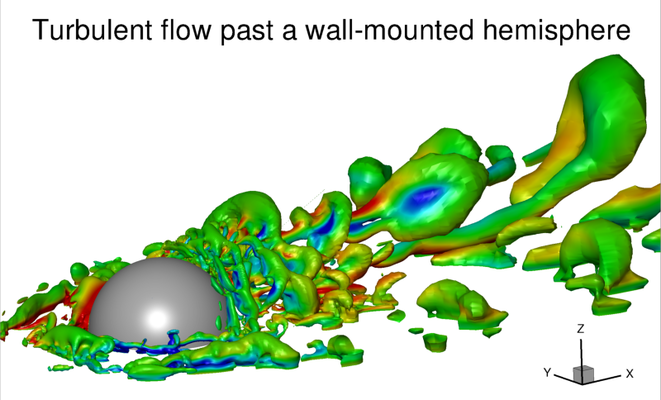Abstr:UFR 3-33
Turbulent flow past a smooth and rigid wall-mounted hemisphere
Semi-confined flows
Underlying Flow Regime 3-33
Abstract
The objective of the present contribution is to provide a detailed experimental and numerical investigation on the turbulent flow past a smooth and rigid wall-mounted hemispherical obstacle. For this purpose, the hemisphere (diameter ) is exposed to a thick turbulent boundary layer of the thickness at Re = 50,000. In order to reproduce the desired boundary layer in the experiment a combination of specific fences are placed in the upstream region of the wind tunnel. Detailed measurements of the inflow conditions are realized using laser-Doppler and hot-film probes. Using them numerical inlet data mimicking the experimental inflow conditions are generated. These clearly defined boundary and operating conditions are the prerequisites for a combined experimental and numerical investigation of the flow field relying on the laser-Doppler anemometry and on a large-eddy simulation.
The numerical results are produced by a finite-volume Navier-Stokes solver for block-structured curvilinear grids. A fine wall-resolved mesh is applied resulting from a preliminary study. A parallel analysis is conducted to select a correct subgrid-scale model.
The final investigation includes a deep analysis on the unsteady flow features observed in the vicinity of the hemisphere like horseshoe vortex, recirculation area, hairpin structure or vortex shedding. A detailed discussion of the time-averaged flow field comprising the mean velocity field as well as the Reynolds stresses is also present. Both, experimental and numerical, results are found to be in close agreement.
 Media:UFR3-33_hemisphere_vorticity_magnitude_from_hell.avi
Media:UFR3-33_hemisphere_vorticity_magnitude_from_hell.avi
Contributed by: Jens Nikolas Wood, Guillaume De Nayer, Stephan Schmidt, Michael Breuer — Helmut-Schmidt Universität Hamburg
© copyright ERCOFTAC 2024


